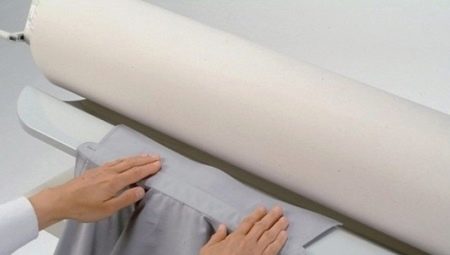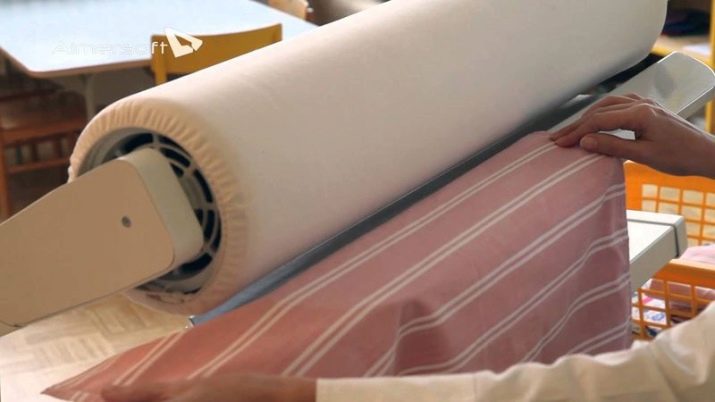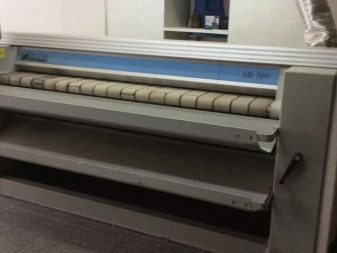Ironing rollers: features, types, advice on selection and use

Household women and men are often faced with repetitive and physically demanding jobs. Ironing of linen belongs to such activities. It would seem that there is nothing difficult in moving the iron over the fabric, and the device itself weighs very little. However, ironing large items such as bed linen or bath towels is time-consuming and labor-intensive, especially if the number of family members is significantly more than 1-2 people.
Today, a special machine comes to the rescue to facilitate the everyday life of a modern person, which is called an ironing rink.


Design specifics
Most often, large and complex ironing machines are used in large industrial plants and in various laundries or dry cleaners. These sophisticated devices are called calenders and are, in fact, the forerunners of the small home ice rink. The very technology of straightening the fabric in a large factory and in a small city apartment remains the same. The fabric is pulled onto the spinning drum and passed under a hot iron roller or along a special chute, which smooths out the folds on it.

Outwardly, such a machine looks like a tall narrow table., on which the feed drum and ironing mechanism are located, and instead of the sides, there are heating elements that supply heat. Management can take place both in automatic and manual modes. In order to start the heating mechanism, you just need to turn on the roller and press the power button, and to move the feed drum, you need to press a special pedal.For convenience, it is placed at the bottom, and the operator presses on it with his foot.


Advantages
A roller ironing machine is much more expensive than an iron and takes up quite a lot of space in an apartment. In addition, it is impossible to iron a shirt or trousers on it, as it is only suitable for working with straight linen, for example, pillowcases or curtains.

It has a specific list of advantages that outweigh these disadvantages.
- After leaving the ironing rink, the surface of the fabric is not only smoothed out from folds, it becomes perfectly smooth and pleasant to the touch, which is almost impossible to achieve with a regular iron without a steamer.
- A person in the process of working with the ironing roller assumes a comfortable position, sitting on a pouf, chair or even in a soft armchair. This is especially important for the elderly and those who have problems with the lumbar spine, as normal ironing takes place in a slight slope, and the load on this area can lead to complications.
- The unfolded ironer takes up a fairly large area, but there are foldable models that fit easily into the bottom drawer of a dresser or wardrobe. In addition, such a unit is convenient to move around the room and unfolded because of the small wheels on which it is installed.

- The processing speed of even the highest mountain of clean linen is very high, and the effort required by the operator is negligible. During the time it takes to iron one pillowcase, the roller skips 3-4 sheets or towels. At the same time, in contrast to manual operation, the density and composition of the fabric practically do not affect the speed of work.
- Unlike a conventional iron, which can easily burn the skin of the body and especially the hands, the hot parts of the ironer are located inside the mechanism. The feed drum is also protected, which reduces the risk of injury to virtually zero.
- Such a large number of advantages over a conventional ironing board and iron or a more modern, but not so fast steamer leads to the fact that more and more owners of even small city apartments prefer to make this expensive purchase.

Varieties
All ironing rollers can be classified according to the complexity of the mechanism, and they are divided into two large groups.
- First group includes equipment with a heating plate located at the very top of the unit. From below, a roller covered with heat-resistant material is pressed against the hot plate, which scrolls the sheet or towel over the hot surface.
Such devices wear out clothes much faster and require preliminary drying in air or in a tumble dryer.

- Second group - these are the so-called drying and ironing devices. In this case, the machine is equipped with a metal roller that heats up and smoothes the laundry with high temperature or steam. Since in this case the pillowcase or duvet cover is not stretched over the surface, but rolled at a soft angle of 300 degrees, the fabric wears out less and remains softer.


By the same criteria, ironing rollers can be divided into:
- grooved;
- calender.


The design of the former includes one heating element and a chute or roller through which the fabric is fed. Electric heating does not allow the laundry to dry out during ironing and requires a cloth with a moisture content of less than 5-10%.
The second devices include two or more drums with electric and steam heating, which must be connected to the exhaust ventilation to remove hot steam. In such skating rinks it is possible to simultaneously iron and dry clothes after washing machines. However, most often such devices are cumbersome and low-mobile, therefore they are installed in large laundries, and not in private houses and apartments.


How to choose a home appliance?
Today, an increasing number of manufacturers of household appliances offer ironing rollers in their assortment.


To choose a quality product that will last for many years and will be convenient to use, you need to decide on a few basic parameters.
- Determine for what purpose the device is purchased. In the presence of a large number of simple items of the same type, such a purchase will indeed be justified. If the number of complex products exceeds the volume of bed linen, towels and curtains, then it is best to purchase a high-quality steamer or a good iron.
- Select the capacity of the unit. The productivity of an ironing roller is the number of things it can process in 1 hour. Larger laundries and dry cleaners require more efficient machines, and even the smallest is suitable for home use.

- Select the dimensions of the roller. Before buying, you should decide on the place of installation of the ironing machine and calculate the maximum allowable dimensions of the device. Most likely, its dimensions will be such that the sheet or duvet cover will have to be ironed, folded in half, otherwise the skating rink will take up almost the entire wall.
- Additional functions. In the event that a drying room is installed together with a washing machine in a house or apartment, it is enough to buy the simplest ice rink without a drying function.
- Shaft diameter. The larger the diameter of the roller, which heats up and smoothes the laundry, the better the result will be. In addition, the productivity of the machine will significantly increase, since re-ironing is definitely not required.


- Pressing the roller to the hot surface can be either manual or automatic. In the first case, the operator himself adjusts the pressing force of the linen, and in the second, it is automatically adjusted. Of course, the second option is more expensive, but the ironing quality will be higher.
- The roller speed can be regulated or constant. The first devices are much more expensive, but also much more convenient to use. Depending on the thickness, quality and moisture content of the fabric, you can reduce or increase the rotation speed of the feed roller, thereby improving the smoothness of the product coming out of the roller.

Having dealt with all the requirements, having studied the reviews on a particular model on the network, you can stop at 1-2 options for a skating rink, which is completely suitable for a particular person or family.
Ironing rules
Different types of products require different handling, but there are certain rules that will work for any ironing machine.
Even high-quality devices with additional drying of linen should not be placed on fabric from which water flows down in jets. The moisture percentage of towels or curtains should not exceed 50.
When the machine is idle, do not use it as a hanger or stand for other items.
It is undesirable to run the roller dry, as this wears out the surface of the rollers and contributes to the breakdown of the device.

Before ironing, the laundry itself must be dried (if a conventional roller is used), shaken slightly by hand and carefully laid on the feed roller. The product should be straightened as a whole or folded in half, deep folds and creases should be straightened out by hand. You should not pull the corners of the product in different directions and even more so try to pull out the edge that has already gone inside the roller. To prevent the side parts of the heating panel or roller from overheating, it is necessary to alternate the feeding of large and small products. Correct use of the ironing machine will allow it to last much longer than the warranty period, while maintaining the original quality of the laundry for a longer period.
For an overview of the ironing rink, see the following video.








